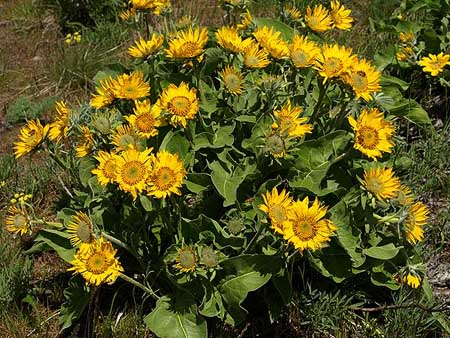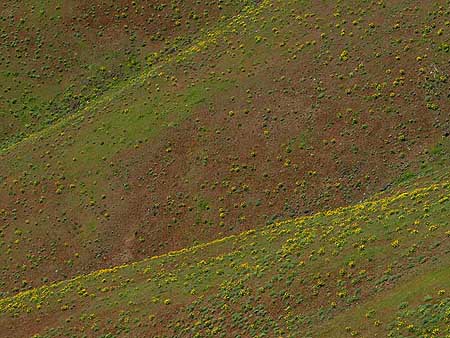
Balsamroot blankets the Dalles Mountain nature preserve in spring; Mount Hood rises from the clouds on the horizon, above the Columbia River and the town of The Dalles
In late spring across the arid mountain west, sunny slopes and open Ponderosa forests explode with bright yellow drifts off Arrowleaf balsamroot (Balsamorhiza sagittata), the native sunflower of the western states. These handsome plants are especially abundant along the dry east slope of the Cascades, where they are also known as Oregon sunflower.
The name “Arrowleaf” describes the large, felted leaves of this plant — though in size they are closer to a spade than an arrowhead, often as much as a foot in length. “Balsamroot” refers to the fist-sized, branched taproot that anchors these plants in their typically windswept, harsh environment. The roots have a strong, pine-scented (or “balsam”) sap. These oversized roots not only draw moisture from deep in the arid soils in which Arrowleaf balsamroot grow, but also allow the plants to easily survive fires.

A typical balsamroot in spring, nearing peak bloom
The flowers are actually complex collection of individual blossoms that give the illusion of a single, large flower head. The outer ring of “petals” emerge from dozens of individual florets, each producing one enormous petal that combine to form the ring of yellow petals. A close look at the developing flower head (below) shows these emerging super-petals as a fringe of green tips.

Honeybee on a balsamroot
Native Americans used almost all parts of these plants for food. Tender shoots and leaves were eaten raw or steamed, and immature flower heads were peeled and eaten. The sunflower-like seeds were eaten dry, or roasted. The roots, which are bitter when raw, were cooked and ground into a meal that was used to make cakes, and dried and powdered to make tea.
The plant was also used for medicinal purposes, with green leaves used to treat burns and the boiled roots used to create a medicinal salve for small wounds. A tea made from the roots was used to treat respiratory ailments. Balsamroot is still used today in organic foods and herbal medicines.
Wildlife also depend on Arrowleaf balsamroot. The plants are tolerant of browsing by deer and elk, and the seeds are important forage for small mammals, such as the Columbia ground squirrel. Wild horses graze on the plants in spring, and are especially fond of the flowers. The plants are also grazed by domestic stock, though they are sensitive overgrazing.

Miles of balsamroot create a brief dusting of bright green and yellow on the desert slopes of the Eastern Gorge each spring
In the right conditions, Arrowleaf balsamroot grow to fill whole mountainsides with their spectacular blooms. As the blooming season of Arrowleaf balsamroot peaks in late April or early May, the Columbia River Gorge provides one of the finer displays anywhere. Blue lupine is a frequent companion plant, providing a painting-perfect complement to the displays.
You can visit some of these spectacular displays by exploring Gorge hiking trails at Dog Mountain, Catherine Creek, Rowena Crest and Dalles Mountain Ranch. Check out the Portland Hikers Field Guide for more information on these destinations.